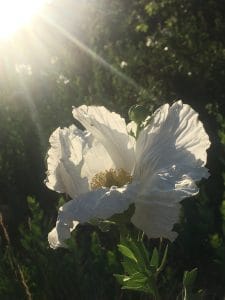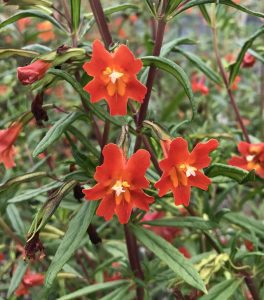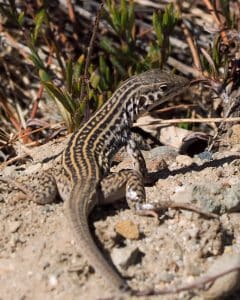Summer solstice coming. Periods of long daylight (for photosynthesis and growth), mild, stable weather (for plant health), soil temperatures on the rise – now warm enough to promote good root growth yet still cool enough to not provide an environment for root rot (for root health). And plenty of time to be outdoors enjoying the last of the spring flowers and the first of the summer (for your health). What a fine month is June in the natural garden! Near the coast, we expect lots of gray days, so maybe we’ll call it “Pre-Summer” since May has been called “Foresummer.” Hang tight, the real thing really will come and you’ll know it when it does.

History, review, current affairs
Our 2017-18 rain year was less than impressive, noteworthy only for its paucity. One of the driest years on record, most southern California stations recorded less than six inches. Even as late as May, when drizzles provided precipitation measured by the hundreth of an inch, barely enough to wet all the leaves, I found myself chuckling when someone would comment on the “rain.” In these newsletters, we track the progress of natural water falling naturally from the sky onto our natural gardens, and we have discussed the absolute need to charge the soil with deep moisture by irrigating. This year we needed to supplement the natural rain we lacked.
Watering
June is an ideal month to thoroughly soak the soil. Get your garden ready now for summer heat coming July through September. Water now, even when, especially when, the plants are not yet showing signs of drought stress.
Choose a cool spell, a period forecast for June gloom, with overcast nights & mornings and mild temps. Utilize such a period to give your garden its thorough soaking. You should employ the pulse irrigation method by watering in early morning – three days in a row to apply a total equivalent of about 1.5+” precipitation. For most sprinkler systems this would require that you water about 20-40 minutes a day, for each of the three days, making a cumulative run time of 1.5 to 2+ hours. You will not need to do this again for 3 or 4+ weeks. More detail on summer irrigation can be found in our Watering Guide.
Supplement your “deep soak” with occasional “refreshing sprinkles.” Twice a week or so, go out in late afternoon / early evening and wet everything down, leaves, mulch, branches, all soil… 5-10 minutes is plenty. This water will not reach the deep root zone, but it will help keep moisture where it belongs in the soil, freshen and wash the leaves, cool the area and give you some quality time at the end of the day, observing the subtle details of your natural garden. Turn the hose straight up and let it rain on you for that special “I truly am one with my garden” feeling.
Related to Watering
Toward the end of June, be ready to do another deep soak, during a period of cool gray days. You are watering now so your garden will not suffer in July, August, and September when summer temps become a factor for drought stress and/or root rot.
Pruning
Since June is all about getting ready for summer, feel free to shape your plants and trim off any really tender new growth that will be hard for the plant to support in hot weather. Manzanitas require no pruning at this time. Remove dead flowers and branch tips from Ceanothus. Old Salvia blooms can be trimmed off. Save your Penstemon seed as you cut off the old seed stalks. Grasses now have lovely seed heads providing movement as they sway in the wind. Leave them on for a few more weeks. Romneya flowers, dried Encelia flowers, and the delicate old blooms of Heuchera can be removed with careful grooming. You will extend the bloom time for many plants by taking the old flowers off.

Weeding
The advantage of infrequent, deep watering events is that weeds become a minor issue, since the top 3 inches of soil is not maintained sopping wet as in so many so-called “California friendly” gardens where water is being applied three times a week for 5 minutes each time. When you see a weed, pull it or grub it out with a hoe.
Mulching/Top dress
Your organic top dress should be in place. Don’t overdo it. Many gardens get smothered in organic mulch which can cause problems in the hot season. If you want to add anything interesting to the surface of your garden, find some old weathered sticks, logs, interesting rocks, twisted branches, burls, etc. and bring them home to provide natural rustic beauty that will increase the habitat value of your place.
Feeding
It is safe to use an all purpose granular organic plant food, broadcasting it as per instructions on the bag. Do this prior to the deep soak irrigation described above. This will be your last feeding until fall rolls in. If you fed your garden earlier this spring, a half-strength application now will suffice.
Troubleshooting – Varmints, Pests and Diseases
Be on the lookout for aphids on new growth. They can show up overnight. Palo verde trees near the coast often get mildew on their leaves this time of year. Salvias, particularly those with fuzzy leaves might get powdery mildew, especially where they get frequent overspray from your neighbor’s sprinklers. Downy mildew is more serious. If you see entire branches of Galvezia, Eriogonum, Salvia, Artemisia, or Ceanothus go brown all at once, it may be related to excess humidity on warm moist nights in, around, and under the plant. Remove organic mulch from the vicinity the plant and thin the branches to allow air circulation. Sanitize your shears between every cut (10% bleach or rubbing alcohol) so you don’t inadvertently spread the disease. Always write me and send photos if you have any questions.
Annual Wildflowers
Too late to sow seed, too early to germinate new plants, but perfect time to start collecting and keeping seed until fall. Pick the seed heads off and store them in paper, not plastic bags, room temperature, dark place.
Adding New Plants
This is an ideal time to plant many of the heat loving natives that do so well and provide such rich summer bloom. Come on over and we’ll help you select plants for your garden, patio, or pots to help make your summer even more colorful. The hummingbirds and butterflies will thank you.

Engage
Are you spending more time outdoors? Nod to the affirmative, please. Set up your garden now so can experience an amazing summer with, as John Muir called them, “our fellow mortals.” You need a comfortable chair for sitting, reading and sleeping. Maybe even a hammock. Shade is helpful. A source of fresh water for birds, bees, and butterflies (birds are attracted to the sound of running water, a drip will do), mud for butterflies, flowers for everyone, old seed as food, safe sites with nesting materials, branch cover, and a secret refugia for all who will call your garden their home. The lizards have been asking for a few boulders and rocks. Do your best.
From the Garden, and Pre-Summer!
Mike Evans
p.s. Don’t forget to check the newsletters for April and May and those from this time last year. This will give you a better context to understand garden care by season.
Questions? Help is just one call or one email away. Call (949) 728-0685 or email (with pictures if you like) our special helpline: gardenhelp@californianativeplants.com.